December 2023 LIP of the Month
Dyke swarm history in Belet-ili and Gaia (Gaya) Coronae region of Central Eistla Regio, Venus
Twinkle Chaddha 1, Richard E. Ernst 2, Hafida El Bilali 2, Rajesh K. Srivastava 1.
1Department of Geology, Banaras Hindu University, Varanasi 221005, India
2Department of Earth Sciences, Carleton University, Ottawa, ON K1S5B6, Canada
This is extracted and modified from Chaddha, T., Ernst, R.E., El Bilali, H., Srivastava, R.K. (2024). Dyke swarm history in Belet-ili and Gaia (Gaya) Coronae Region (13◦–26◦E, 0◦–10◦N), Central Eistla Regio, Venus. Icarus, v. 410, 115893, https://doi.org/10.1016/j.icarus.2023.115893
Venus is a paradise for studying mafic dyke swarms, Large Igneous Provinces (LIPs) and mantle plumes (e.g. Ernst et al. 1995; Head and Coffin, 1997; Hansen 2007; Ernst, 2014; Buchan and Ernst, 2021; El Bilali et al. 2023). The absence of erosion due to the extreme surface conditions also provides the advantage of preserving the surface expression of LIPs. The prior November 2023 LIP of the Month http://www.largeigneousprovinces.org/23nov (based on El Bilali et al. 2023) profiled major radiating mafic dyke swarms associated with a large mantle plume centre, Atla Regio. In this December 2023 LIP of the Month, we look at mafic dyke swarms associated with a collection of smaller-size plumes in the central portion of Eistla Regio.
Venus is similar to the Earth in size and overall internal structure, but differs dramatically in having a high surface temperature (450 ◦C) and atmospheric pressure (90 times that of Earth), dominated by CO2 (e.g. Solomon et al. 1992). Venus exhibits no plate tectonics and no fluvial erosion (although minor erosion through wind may occur). Owing to the absence of plate tectonics (at least for the past approximately billion years), all the volcanism is intraplate, which invites comparisons with terrestrial intraplate magmatism including that of the largest scale, LIPs (Ernst et al. 1995; Head and Coffin, 1997; Hansen 2007; Buchan and Ernst, 2021). Venus hosts volcanic rises (with LIP-scale magmatism) which are generally considered to form above large mantle plumes, analogous to terrestrial plumes originating from the deep mantle (Senske et al., 1992; Stofan et al., 1995; Ivanov and Head, 2013; Head and Coffin, 1997; Hansen et al., 1997; Smrekar et al., 1997; Ernst and Desnoyers, 2004; Stofan and Smrekar, 2005; Hansen, 2007; Hansen, 2018; El Bilali et al., 2023). The extent of these volcanic rises varies from 1000 to 2500 km in diameter and 1 to 2.5 km in height. They are recognized by their broad, gentle, dome-like topography and relatively deep apparent depths of compensation as suggested by the gravity signatures. The volcanic rises are classified into three categories on the basis of their morphology: rift-dominated (Atla and Beta Regio), volcano-dominated (Dione, Western Eistla, Bell and Imdr Regio) and corona-dominated (Themis, Eastern Eistla and Central Eistla Regio (Stofan et al., 1995; Smrekar and Stofan, 1999).
Coronae are quasi-circular/elliptical magma-tectonic features ranging in diameter from <100 km to 2600 km. They have several characteristic features, including the presence of a variably-shaped circular (to sub-circular to irregularly shaped) annulus and/or trough which is deformed by concentric faults and folds, and the association with volcanic flows and edifices (Stofan et al., 1992; Smrekar and
Stofan, 1997; Grindrod and Hoogenboom, 2006; Guseva and Ivanov, 2020; Gülcher et al., 2020). They are considered the surface manifestation of upwelling mantle plumes although other origins have been proposed. Recent studies have suggested that circumferential extensional lineaments (grabens, fissures and fractures) of coronae can be the surface expression of dykes, and analogous to terrestrial circumferential mafic dyke swarms (e.g. Buchan and Ernst, 2021).
Eistla Regio, locus of major plume-generated magmatism and tectonics. We focus on the central portion, termed Central Eistla Regio and focus on two corona Belet-ili and Gaia (Gaya) (Fig. 1). We mapped more than 19,000 extensional lineaments (grabens, fissures and fractures) (Fig. 2) in the study area (13◦-26◦E, 0◦-10◦N) at 1:500,000 scale using full resolution Magellan Synthetic Aperture Radar (SAR) images with resolution of 75 m per pixel. These structures are interpreted to represent the surface expression of underlying mafic dykes and have been grouped, on the basis of trend, into radiating, circumferential and linear dyke swarms. Thirty-two dyke swarms were identified and linked to 20 magmatic centres, most of which are located within or near two coronae, Belet-ili and Gaia (Gaya) coronae, while others are linked to magmatic centres outside the study area (Fig. 3).
These magmatic centres are interpreted to be linked to underlying mantle plumes, and the sizes of the underlying flattened plume heads are estimated from the interpreted dyke swarms (Fig. 3, 4): for radiating swarms, the radius of the transition from proximal radiating to more distal linear pattern, and for circumferential dykes, the radial distance to the outer boundary of the circumferential pattern (Baragar et al. 1996; Buchan and Ernst 2019, 2021; El Bilali et al. 2023). Plume heads for the largest centres, Belet-ili and Gaia coronae are estimated at about 230 km and 275 km in radius, respectively. These sizes are less than the 1200 km radii predicted for a plume arriving from the deep mantle, and would suggest an origin at a shallower level (likely a mid-mantle boundary, i.e. between upper and lower mantle). The NW alignment of Belet-ili and Gaia corona and other magmatic centres in our study area (Fig. 4) potentially represents structural control by a rift zone, which can be traced further north to Anala Mons, one of two main plume centres of Central Eistla Regio (Fig. 5).
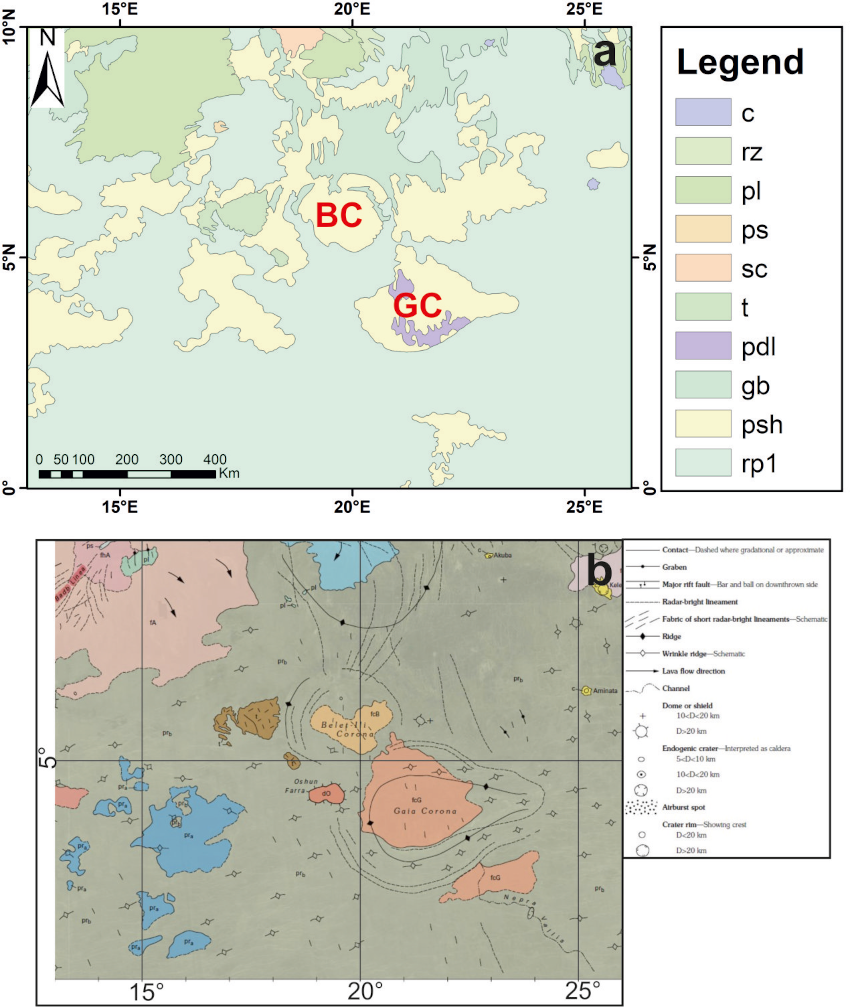
Figure 1. Previous geological maps of the study area. (a) Portion of global geological map at the scale of 1:10,000,000 scale (Ivanov and Head, 2011). BC = Belet-ili corona, GC = Gaia Corona, c = impact craters, rz = rift zones, pl = lobate plains, ps = smooth plains, sc = shield clusters, t = tessera, pdl = densely lineated plains, gb = groove belts, psh = shield plains, rp = regional plains). Portion of Sappho Patera Quadrangle V-20 (McGill, 2000) (1:5,000,000 scale).
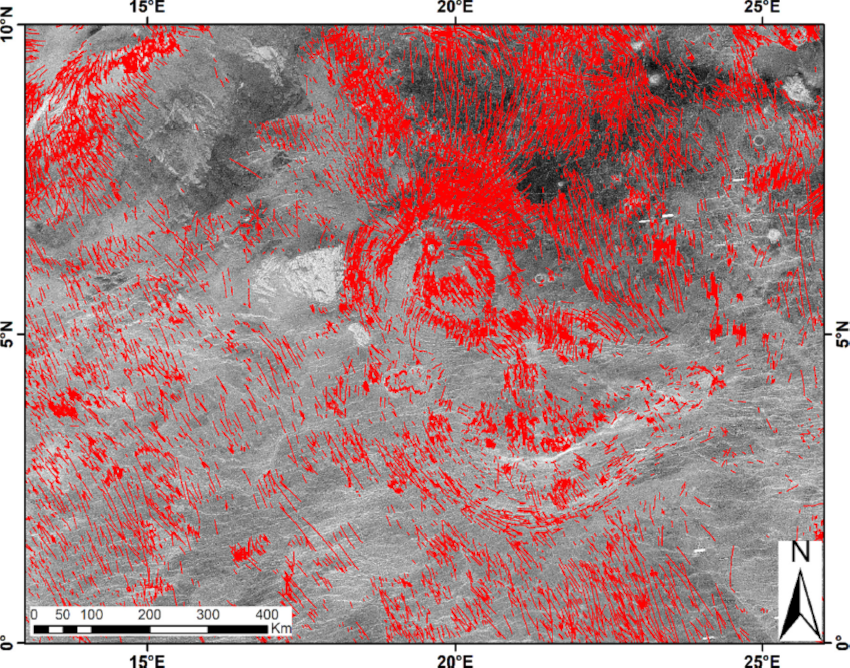
Figure 2. Mapping of 19,0000 graben-fissure-fracture lineaments (interpreted to overlie mafic dykes) in the study area on Magellan SAR image background.
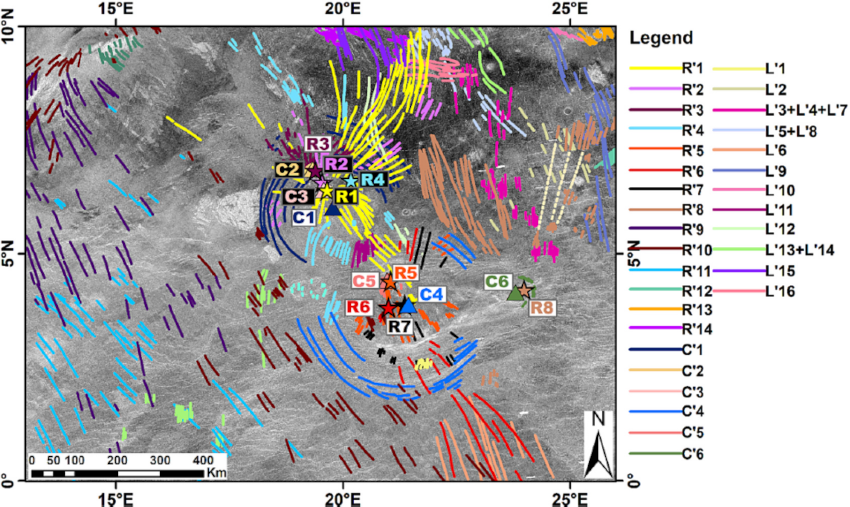
Figure 3. Generalized graben fissure systems (dyke swarms) in the study area with colours for swarms keyed to the legend. Centres are labelled on the map. Stars represent centres for radiating swarms whereas triangles denote centres for circumferential swarms.
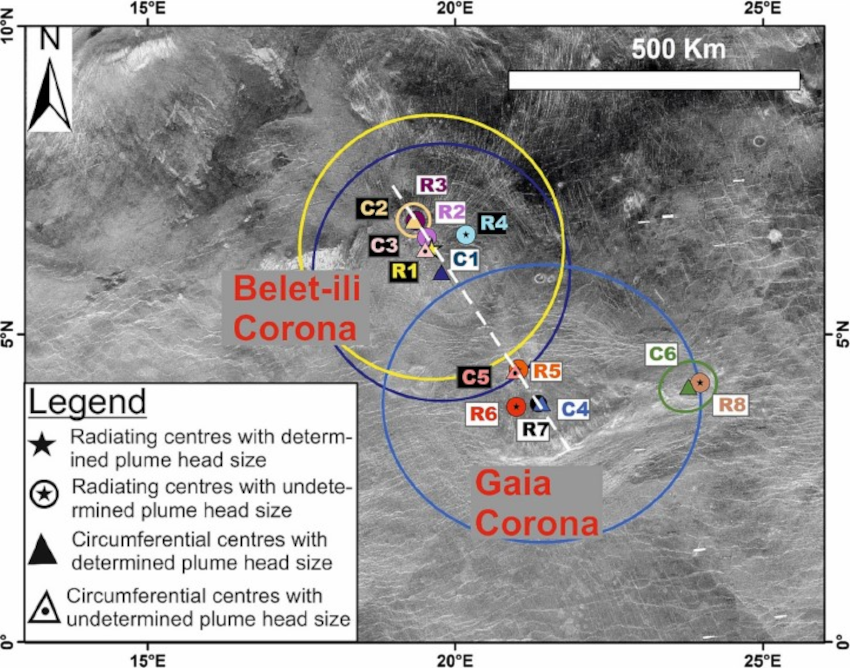
Figure 4: Comparative study of plume head sizes identified in the study area determined from radiating and circumferential dyke swarms as discussed in text and detailed in Chaddha et al. (2023). The centre of the plume head and its edge are shown in same colour.
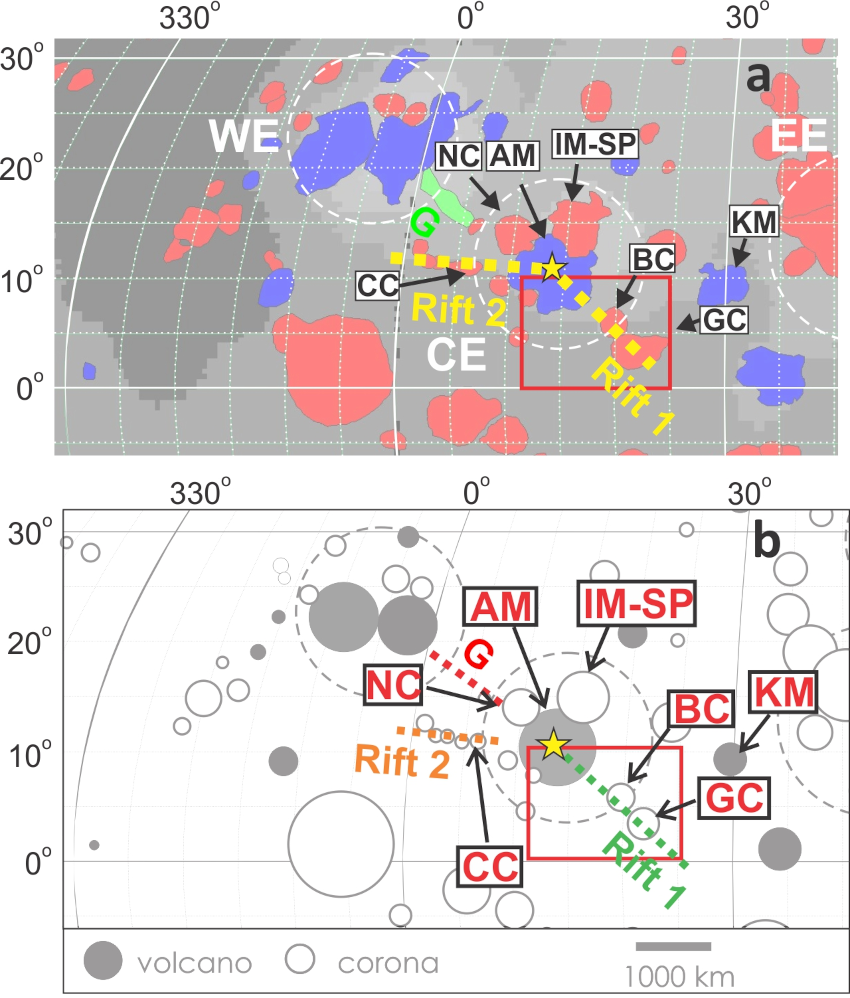
Figure 5. Relationship of Belet-ili corona (BC) and Gaia Corona (GC) with respect to other centres of Central Eistla Regio after Ernst and Desynoyers (2004) with additional information superimposed. Locations of additional centres are: AM = Anala Mons, IM-SP = Irnini Mons-Sappho Patera, KM = Kali Mons, CC = Changko Corona, NC = Nehalennia Corona. a) after Ernst and Desnoyers, 2004, with base geology map modified from Herrick (1999); red areas represent coronae while the blue represent mons (volcanoes) and green represent a rift zone. b) schematic version after Ernst and Desnoyers, 2004. Two possible rift arms (Rift 1 and Rift 2) are suggested (see discussion in text), which along with Guor linea rift (McGill, 2000), diverge from the main magmatic centre (Anala Mons); it is a potentially the locus of a large Central Eistla Regio plume.
References
Baragar, W.R.A., Ernst, R.E., Hulbert, L., Peterson, T., 1996. Longitudinal petrochemical variation in the Mackenzie dyke swarm, northwestern Canadian Shield. J. Petrol. 37 (2), 317–359.
Buchan, K.L., Ernst, R.E., 2019. Giant circumferential dyke swarms: Catalogue and characteristics. In: Srivastava, R.K., Ernst, R.E., Peng, P. (Eds.), Dyke Swarms of the World: A Modern Perspective. Springer Singapore, pp. 1–44
Buchan, K.L., Ernst, R.E., 2021. Plumbing systems of large igneous provinces (LIPs) on earth and Venus: investigating the role of giant circumferential and radiating dyke swarms, coronae and novae, and mid-crustal intrusive complexes. Gondw. Res. 100,25–43
Chaddha, T., Ernst, R.E., El Bilali, H., Srivastava, R.K. (2024). Dyke swarm history in Belet-ili and Gaia (Gaya) Coronae Region (13◦–26◦E, 0◦–10◦N), Central Eistla Regio, Venus. Icarus, v. 410, 115893, https://doi.org/10.1016/j.icarus.2023.11589
El Bilali, H., Ernst, R.E., Buchan, K.L., Head, J.W., 2023. Dyke swarms record the plume stage evolution of the Atla Regio superplume on Venus. Commun. Earth Environ. 4 (1), 235.
Ernst, R.E. 2014. Large Igneous Provinces. Cambridge University Press. 653 p.
Ernst, R.E., Desnoyers, D.W., 2004. Lessons from Venus for understanding mantle plumes on Earth. Phys. Earth Planet. Interiors 146, 195–229 [corrigendum 2005, 149, 371].
Ernst, R.E., Head, J.W., Parfitt, E., Grosfils, E., Wilson, L., 1995. Giant radiating dyke swarms on Earth and Venus. Earth Sci. Rev. 39 (1–2), 1–58.
Grindrod, P.M., Hoogenboom, T., 2006. Venus: the corona conundrum. Astron. Geophys. 47 (3), 3.16–3.21.
Gülcher, A.J.P., Gerya, T.V., Montesi, L.G., Munch, J., 2020. Corona structures driven by plume–lithosphere interactions and evidence for ongoing plume activity on Venus. Nat. Geosci. 13, 547–554. https://doi.org/10.1038/s41561-020-0606-1.
Guseva, E.N., Ivanov, M.A., 2020. Structures of coronae on Venus: results of topographic and geologic analysis. Sol. Syst. Res. 54, 497–503.
Hansen, V.L., 2007. LIPs on Venus. Chem. Geol. 241, 354–374.
Hansen, V.L., 2018. Global tectonic evolution of Venus, from exogenic to endogenic over time, and implications for early Earth processes. Phil. Trans. R. Soc. A 376 (2132), 20170412
Hansen, V.L., Willis, J.J., Banerdt, W.B., 1997. Tectonic overview and synthesis. In: Bougher, S.W., Hunten, D.M., Phillips, R.J. (Eds.), Venus II: Geology, Geophysics, Atmosphere, and Solar Wind Environment. University of Arizona Press, Tucson, AZ, pp. 797–844
Head, J.W., Coffin, M.F., 1997. Large igneous provinces: a planetary perspective. In: Mahoney, J.J., Coffin, M.F. (Eds.), Large Igneous Provinces: Continental, Oceanic, and Planetary Flood Volcanism AGU Geophysical Monograph, 100, pp. 411–438.
Herrick, R.R., 1999. Small mantle upwellings are pervasive on Venus and Earth. Geophys. Res. Lett. 26, 803–806.
Ivanov, M.A., Head, J.W., 2011. Global geological map of Venus. Planet. Space Sci. 59 (13), 1559–1600.
Ivanov, M.A., Head, J.W., 2013. The history of volcanism on Venus. Planet. Space Sci. 84, 66–92.
McGill, G.E., 2000. Geologic map of the Sappho Patera quadrangle (V-20), Venus. In: U.S. Geological Survey Map I, p. 2637.
Senske, D.A., Schaber, G.G., Stofan, E.R., 1992. Regional topographic rises on Venus: Geology of western Eistla Regio and comparison to Beta Regio and Atla Regio. J. Geoph. Res.: Planets 97 (E8), 13395–13420
Smrekar, S.E., Stofan, E.R., 1999. Origin of Corona-Dominated Topographic Rises on Venus. Icarus 139 (1), 100–115.
Smrekar, S.E., Stofan, E.R., 1997. Corona formation and heat loss on Venus by coupled upwelling and delamination. Science 277 (5330), 1289–1294.
Smrekar, S.E., Kiefer, W.S., Stofan, E.R., 1997. Large volcanic rises on Venus. In: Bougher, S.W., et al. (Eds.), Venus II: Geology, Geophysics, Atmosphere, and Solar Wind Environment. The University of Arizona Press, pp. 845–878. https
Solomon, S.C., et al., 1992. Venus tectonics: an overview of Magellan observations. J. Geophys. Res. Planets 97, 13199–13255. https://doi.org/10.1029/92JE01418.
Stofan, E.R., Smrekar, S.E., 2005. Large topographic rises, coronae, large flow field, and large volcanoes on Venus: Evidence for mantle plumes? Geol. Soc. Am. Spec. Pap., 388, 841–861.
Stofan, E.R., Sharpton, V.L., Schubert, G., Baer, G., Bindschadler, D.L., Janes, D.M., Squyres, S.W., 1992. Global distribution and characteristics of coronae and related features on Venus: implications for origin and relation to mantle processes. J. Geophys. Res.: Planets 97 (E8), 13347–13378.
Stofan, E.R., Smrekar, S.E., Bindschadler, D.L., Senske, D.A., 1995. Large topographic rises on Venus: implications for mantle upwelling. J. Geophys. Res.: Planets 100 (E11), 23317–23327.
